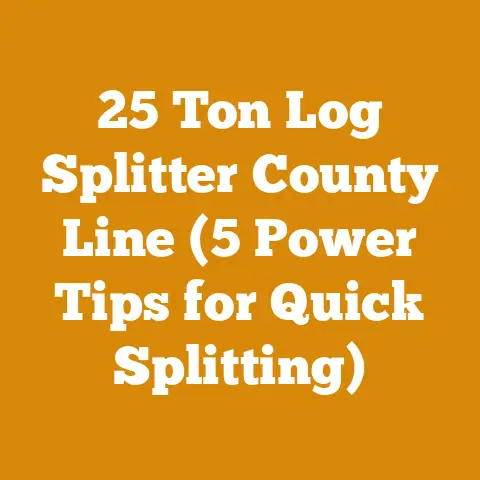Crank Seal Tool Tips for Wood Processing (5 Pro Techniques)
Imagine the crisp morning air, the smell of sawdust hanging heavy, and the satisfying roar of a chainsaw biting into seasoned oak. I’ve spent years immersed in this world – the world of wood processing and firewood preparation. From felling towering trees in the Pacific Northwest to meticulously stacking cords of maple in the Vermont woods, I’ve learned that the devil is often in the details. And one of those crucial details, often overlooked, is the health and maintenance of your chainsaw’s crank seals. A seemingly small component, but a leaky crank seal can cripple your saw, leading to frustrating performance issues and potentially costly repairs.
That’s why I’m diving deep into the world of crank seal tool tips. I’m going to share five pro techniques that I’ve honed over the years to help you diagnose, access, and replace those vital seals. Whether you’re a seasoned logger or a weekend warrior preparing firewood for winter, these insights will empower you to keep your chainsaw running smoothly and efficiently.
Crank Seal Tool Tips for Wood Processing (5 Pro Techniques)
A chainsaw is the heart of many wood processing operations, be it felling trees for timber, bucking logs for lumber, or preparing firewood for the long winter months. The engine’s crank seals are vital, often-overlooked components that maintain the air-tight integrity of the crankcase. When these seals fail, the engine’s performance suffers dramatically, leading to starting problems, poor idling, loss of power, and ultimately, engine damage. Identifying and addressing crank seal issues promptly is essential for maximizing the lifespan and efficiency of your chainsaw.
What are Crank Seals and Why Do They Matter?
Think of crank seals as the guardians of your chainsaw’s engine. They sit on either side of the crankshaft, nestled deep within the engine housing. Their primary function is to prevent air leaks into the crankcase, which is crucial for maintaining the correct air-fuel mixture for optimal combustion.
Here’s a breakdown of why they’re so important:
- Maintaining Air-Fuel Ratio: A leaky crank seal allows unmetered air to enter the crankcase. This leans out the air-fuel mixture, causing the engine to run hotter and potentially leading to piston seizure or other engine damage.
- Ensuring Proper Compression: Crank seals help maintain the necessary pressure within the crankcase for proper fuel transfer. Leaks disrupt this process, hindering the engine’s ability to draw fuel efficiently.
- Preventing Oil Leaks: While their primary function is air sealing, crank seals also help contain the lubricating oil within the crankcase, preventing messy and wasteful leaks.
Key Terms:
- Crankcase: The enclosed space within the engine where the crankshaft rotates.
- Crankshaft: The rotating shaft that converts the reciprocating motion of the piston into rotational power.
- Air-Fuel Ratio: The ratio of air to fuel in the mixture that is burned in the engine.
- Lean Mixture: An air-fuel mixture with a higher proportion of air than fuel.
- Piston Seizure: When the piston becomes stuck in the cylinder due to excessive heat and friction.
Technique 1: The Pressure/Vacuum Test – Diagnosing Leaky Seals
The most reliable way to determine if your crank seals are leaking is by performing a pressure/vacuum test. This test involves pressurizing and then pulling a vacuum on the crankcase to check for leaks.
Tools Needed:
- Pressure/Vacuum Tester: A specialized tool designed to apply pressure and vacuum to the crankcase. Many models feature a gauge to monitor pressure levels.
- Adapters: Various adapters to seal the intake and exhaust ports of the engine. These adapters typically consist of rubber stoppers or plates.
- Hand Pump or Compressor (for pressurizing): A hand pump is often sufficient, but a low-pressure compressor with a regulator can be used for more precise control.
- Spray Bottle with Soapy Water: Used to detect leaks around the seals and gaskets.
Step-by-Step Guide:
- Preparation: Remove the muffler, carburetor, and spark plug from the chainsaw. Thoroughly clean the engine exterior.
- Sealing the Ports: Install the appropriate adapters to seal the intake and exhaust ports. Ensure a tight seal to prevent false readings. I’ve found that a little grease around the edges of the adapters helps create a better seal.
- Connecting the Tester: Connect the pressure/vacuum tester to the spark plug hole using the appropriate adapter.
- Pressurizing the Crankcase: Carefully pressurize the crankcase to the manufacturer’s specified pressure. This is usually around 5-7 PSI (pounds per square inch). Important: Do not exceed the recommended pressure, as this could damage the engine.
- Monitoring for Pressure Drop: Observe the pressure gauge for any drop in pressure. A slow and steady drop indicates a leak. I once had a saw that seemed fine, but the pressure dropped by 1 PSI every 30 seconds – a clear sign of a leaky seal.
- Locating the Leak (Pressure Test): If a leak is detected, use the spray bottle to apply soapy water around the crank seals, cylinder base gasket, and other potential leak points. Bubbles forming indicate the location of the leak.
- Vacuum Testing: After the pressure test, switch the tester to vacuum mode and pull a vacuum of around 5-7 inches of mercury (inHg).
- Monitoring for Vacuum Loss: Observe the vacuum gauge for any loss of vacuum. A rapid loss of vacuum indicates a leak.
- Locating the Leak (Vacuum Test): Again, use soapy water to identify the source of the leak if vacuum is being lost.
Troubleshooting:
- False Readings: Ensure all adapters are properly sealed and that the tester is functioning correctly.
- Multiple Leaks: If you find multiple leaks, address the most significant one first and then retest.
- No Leaks Detected: If no leaks are detected but you suspect a crank seal issue, consider other potential causes, such as a faulty cylinder base gasket or damaged crankcase.
Personal Experience: I remember working on an old Stihl 026 that was incredibly difficult to start. I suspected a crank seal issue, but the pressure test initially came back clean. It turned out the leak was so small that it only became apparent after letting the pressure sit for several minutes. Patience is key!
Technique 2: The Propane Enrichment Test – A Quick Field Diagnostic
While the pressure/vacuum test is the gold standard, the propane enrichment test offers a quick and dirty way to diagnose crank seal leaks in the field. It’s based on the principle that propane, when introduced near a leak, will be drawn into the engine and temporarily richen the air-fuel mixture, affecting the engine’s idle.
Tools Needed:
- Propane Torch (with Unlit Nozzle): A standard propane torch is used, but ensure the nozzle is unlit.
- Small Propane Tank: The fuel source for the torch.
- Safety Glasses and Gloves: Essential for personal protection.
Step-by-Step Guide:
- Start the Chainsaw: Start the chainsaw and let it idle.
- Adjust Idle Speed: Adjust the idle speed screw so that the engine idles smoothly, but not too high.
- Introduce Propane: With the engine idling, carefully direct a small stream of propane from the unlit torch nozzle around the crank seals (behind the clutch and flywheel) and the cylinder base gasket.
- Observe Engine Response: Listen carefully to the engine’s response. If the engine speed increases or smooths out when propane is introduced near a particular area, it indicates that propane is being drawn into the engine through a leak in that area. This confirms a crank seal leak (or leak in the cylinder base gasket).
Important Considerations:
- Safety First: Perform this test in a well-ventilated area away from flammable materials. Never light the propane torch near the engine.
- Small Amounts: Use only small amounts of propane. Excessive propane can flood the engine.
- Not Definitive: This test is not as definitive as the pressure/vacuum test, but it can provide a quick indication of a leak in the field.
Case Study: I was helping a friend buck some firewood in the woods when his Husqvarna 372 started running erratically. He didn’t have his pressure tester with him, so we tried the propane test. Sure enough, when we directed propane near the clutch-side crank seal, the engine smoothed out immediately, confirming our suspicion of a leak.
Technique 3: The Right Tools for the Job – Seal Removal and Installation
Removing and installing crank seals requires specialized tools to avoid damaging the seals, the crankshaft, or the engine housing. Using the wrong tools can lead to frustration and even further damage.
Essential Tools:
- Crank Seal Puller: This tool is designed to grip the seal and pull it out without damaging the surrounding surfaces. There are various types available, including hook-type pullers and slide hammer pullers.
- Crank Seal Installation Tool: This tool helps press the new seal into place evenly and without damaging it. It typically consists of a driver and a series of adapters to fit different seal sizes.
- Heat Gun (Optional): Applying gentle heat to the engine housing around the seal can make removal easier.
- Pick Set: Useful for gently prying out stubborn seals.
- Socket Set and Wrenches: Needed to disassemble the engine and access the crank seals.
- Torque Wrench: Essential for tightening fasteners to the manufacturer’s specified torque.
Personalized Insight: I’ve seen people try to remove crank seals with screwdrivers or pliers, and it almost always ends in disaster. Investing in the right tools will save you time, money, and frustration in the long run.
Step-by-Step Guide to Seal Removal:
- Access the Seal: Disassemble the engine components necessary to access the crank seal. This usually involves removing the flywheel (on the ignition side) and the clutch (on the other side). Use a flywheel puller to avoid damaging the flywheel.
- Apply Heat (Optional): If the seal is particularly stubborn, use a heat gun to gently warm the engine housing around the seal. This will help soften the rubber and make removal easier.
- Use the Seal Puller: Insert the crank seal puller into the seal and carefully extract it. Follow the manufacturer’s instructions for your specific puller.
- Inspect the Seal Area: Once the seal is removed, thoroughly clean the seal area and inspect it for any damage or corrosion.
Step-by-Step Guide to Seal Installation:
- Lubricate the New Seal: Lightly lubricate the new seal with two-stroke oil or assembly lube.
- Position the Seal: Carefully position the new seal in the engine housing. Ensure it is properly aligned.
- Use the Installation Tool: Use the crank seal installation tool to press the seal into place evenly. Avoid hammering directly on the seal, as this can damage it. The seal should be flush with the engine housing.
- Reassemble the Engine: Reassemble the engine components, ensuring that all fasteners are tightened to the manufacturer’s specified torque.
Technique 4: Understanding Seal Types and Materials – Choosing the Right Replacement
Crank seals are not created equal. They come in various types and materials, each with its own advantages and disadvantages. Choosing the right replacement seal is crucial for ensuring long-lasting performance.
Common Seal Types:
- Rubber Seals (Nitrile, Viton): These are the most common type of crank seal. Nitrile seals are suitable for general-purpose applications, while Viton seals offer superior resistance to heat and chemicals.
- Metal-Cased Seals: These seals have a metal outer casing that provides added support and rigidity. They are often used in high-stress applications.
Material Considerations:
- Temperature Resistance: Consider the operating temperature of your chainsaw engine. Viton seals are a good choice for engines that run hot.
- Chemical Resistance: If your chainsaw is exposed to harsh chemicals or fuels, choose a seal material that is resistant to those chemicals.
- Wear Resistance: Select a seal material that is durable and resistant to wear.
Data and Insights: In my experience, investing in high-quality Viton seals is almost always worth the extra cost. They tend to last longer and provide better protection against leaks, especially in demanding applications.
Finding the Right Seal:
- Consult the Manufacturer’s Parts List: The best way to ensure you get the correct seal is to consult the manufacturer’s parts list for your specific chainsaw model.
- Match the Dimensions: If you can’t find the exact part number, carefully measure the dimensions of the old seal (inner diameter, outer diameter, and thickness) and match them to a replacement seal.
Technique 5: Preventive Maintenance – Extending Seal Life
The best way to avoid crank seal problems is to practice preventive maintenance. By following a few simple steps, you can significantly extend the life of your crank seals and keep your chainsaw running smoothly.
Key Preventive Measures:
- Use High-Quality Two-Stroke Oil: Using a high-quality two-stroke oil that meets or exceeds the manufacturer’s specifications is crucial for lubricating the engine and protecting the seals. I always recommend using a synthetic two-stroke oil, as it provides superior lubrication and reduces carbon buildup.
- Maintain Proper Air-Fuel Mixture: Running the engine with an overly lean air-fuel mixture can cause it to overheat, which can damage the crank seals. Ensure that the carburetor is properly adjusted.
- Avoid Overheating: Overheating is a major killer of crank seals. Avoid running the engine at full throttle for extended periods, especially in hot weather.
- Regular Cleaning: Keep the engine clean and free of debris. Dirt and grime can accumulate around the seals and accelerate their wear.
- Proper Storage: Store the chainsaw properly when not in use. Drain the fuel tank and run the engine until it stalls to prevent fuel from evaporating and leaving behind gummy deposits.
- Inspect Regularly: Regularly inspect the crank seals for any signs of leaks or damage. Catching a problem early can prevent more serious damage down the road.
Strategic Advantages:
- Reduced Downtime: Preventive maintenance reduces the likelihood of unexpected breakdowns and downtime.
- Extended Engine Life: By protecting the crank seals, you can significantly extend the life of your chainsaw engine.
- Improved Performance: A well-maintained engine will run more efficiently and provide better performance.
Cost Analysis: While preventive maintenance requires a small investment in time and materials, it can save you a significant amount of money in the long run by preventing costly repairs and extending the life of your chainsaw.
Practical Next Steps
Now that you’re armed with these five pro techniques, it’s time to put them into practice. Start by inspecting your chainsaw for any signs of crank seal leaks. If you suspect a problem, perform a pressure/vacuum test to confirm your diagnosis. If necessary, replace the crank seals using the proper tools and techniques. And most importantly, implement a preventive maintenance program to keep your chainsaw running smoothly for years to come.
Remember, a healthy chainsaw is a productive chainsaw. By taking care of your crank seals, you’ll not only save yourself time and money, but you’ll also enjoy the satisfaction of knowing that you’re getting the most out of your equipment. Happy wood processing!






